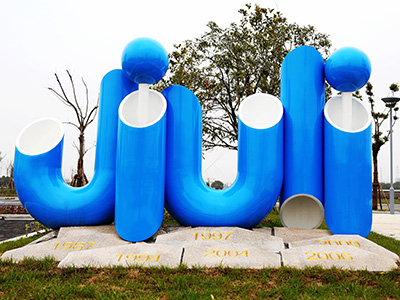Manganese is a weak austenite forming element, it is a deoxidizer in stainless steel, the amount of manganese in steel is generally ≤1% or ≤2%. With the increase of manganese content in stainless steel, the solubility of nitrogen in steel can be significantly improved (Fig. 1). Manganese and nitrogen compounds are often used to replace expensive and scarce nickel in steel. Need to point out that, to the stainless steel composite add manganese, nitrogen, and can only be obtained from tissue to tissue instead of nickel austenite, but it can't instead of nickel on the corrosion resistance of stainless steel, it is also because of manganese element itself characteristics, in the determination of manganese can not improve the thermodynamic stability of stainless steel, also can't any beneficial effect on passivation behavior of the steel.

Fig. 1. Solubility of nitrogen in stainless steels with 14%Ni and different Cr and Mn contents
Early to Mn, nitrogen compound to join instead of 17-7 and 18 8 stainless steel in the nickel, the United States developed AISI200 Cr - Mn - N, modern times, in the development of super austenitic and super duplex stainless steel in the process, also began to add a small amount of manganese steel, can increase the nitrogen content in steel, stability or control appropriate proportion, and can improve the performance of the steel, and can also save nickel element. For the same purpose, several economical dual-phase stainless steels have recently been introduced with small amounts of manganese.
The effect of manganese on the corrosion resistance of stainless steel is basically negative. And included in the pitting resistance index (Cr)+ 3.3(Mo)+30(N)-(Mn) formula. Fig. 2, Fig. 3 and Fig. 4 show the effect of manganese on the pitting and cream-corrosion resistance of Cr-Ni, Cr-Mn-N austenite and dual-phase stainless steels. It can be seen that the pitting corrosion resistance and crevice corrosion resistance of steel decrease with the increase of manganese content. This is related to the formation of MnS by manganese and sulfur, or with the increase of manganese in the steel, the increase of MnS, the low amount of chromium in MnS, MnS dissolved in the corrosive medium, often become the source of pitting and crevice corrosion. Some tests indicate that the pitting resistance of 18-8 stainless steel may reach the level of 0Cr18Ni12Mo2(316) containing 2%Mo when the manganese content is reduced to about 0.1%.
图2.锰对Cr-Ni奥氏体不锈钢耐点蚀性的影响

图3.锰对Cr-Mn-N不锈钢耐点蚀性的影响

图4.在人造海水中,锰量对00Cr25Ni5Mo3N(URANUS50)钢耐点蚀、耐缝隙腐蚀性能的影响
为了发展以锰、氮代镍不锈钢和为增加钢中氮的溶解度,进一步发挥氮在钢中的有益作用,开发加少量锰的奥氏体不锈钢和双相不锈钢时都要充分注意锰在不锈钢中对耐蚀性,特别是耐点蚀性的不利影响。
锰在不锈钢中的有益作用一是形成MnS,抑制含镍的不锈钢中硫的有害作用,提高钢的热塑性;二是在焊接材料中加入2%以上的锰,可提高奥氏体不锈钢的焊缝抗热裂纹的敏感性。
锰在不锈钢中还会促进σ相等脆性相的析出(图5),降低钢的塑、韧性,这也为锰在高铬、钼不锈钢中的应用带来不利影响。(转自不锈钢概论)

图5.锰对00Cr25Ni5Mo3N(URANUS50)钢σ相形成倾向的影响


















